Attached files
| file | filename |
|---|---|
| EX-99.1 - EX-99.1 - F-star Therapeutics, Inc. | d60619dex991.htm |
| EX-16.1 - EX-16.1 - F-star Therapeutics, Inc. | d60619dex161.htm |
| EX-10.7 - EX-10.7 - F-star Therapeutics, Inc. | d60619dex107.htm |
| EX-10.6 - EX-10.6 - F-star Therapeutics, Inc. | d60619dex106.htm |
| EX-10.5 - EX-10.5 - F-star Therapeutics, Inc. | d60619dex105.htm |
| EX-10.4 - EX-10.4 - F-star Therapeutics, Inc. | d60619dex104.htm |
| EX-10.3 - EX-10.3 - F-star Therapeutics, Inc. | d60619dex103.htm |
| EX-10.2 - EX-10.2 - F-star Therapeutics, Inc. | d60619dex102.htm |
| EX-10.1 - EX-10.1 - F-star Therapeutics, Inc. | d60619dex101.htm |
| EX-3.2 - EX-3.2 - F-star Therapeutics, Inc. | d60619dex32.htm |
| EX-3.1 - EX-3.1 - F-star Therapeutics, Inc. | d60619dex31.htm |
| 8-K - 8-K - F-star Therapeutics, Inc. | d60619d8k.htm |
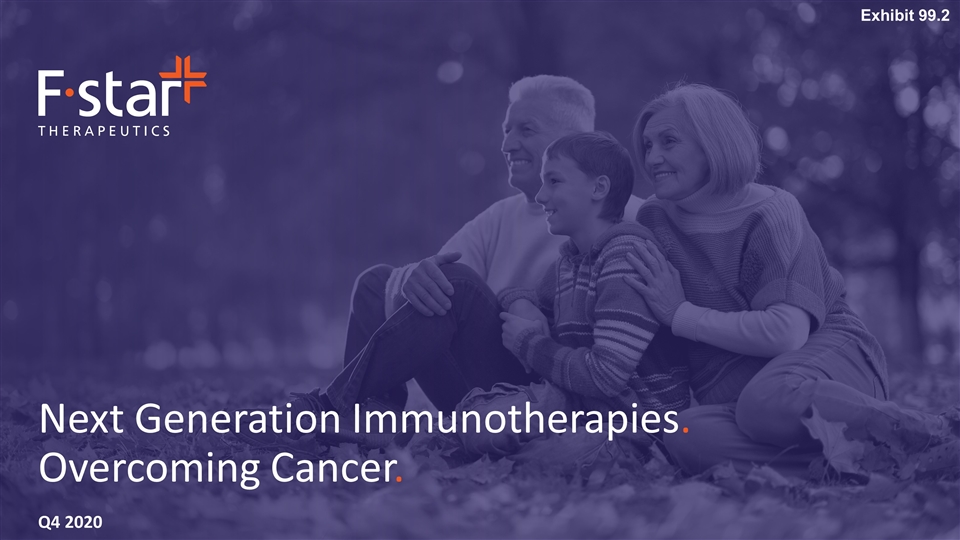
Q4 2020 Next Generation Immunotherapies. Overcoming Cancer. Exhibit 99.2
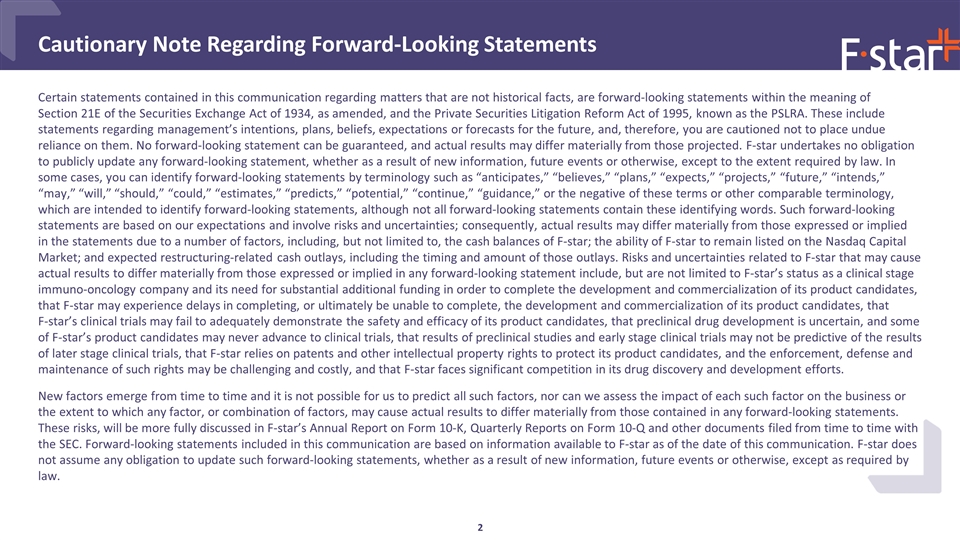
Certain statements contained in this communication regarding matters that are not historical facts, are forward-looking statements within the meaning of Section 21E of the Securities Exchange Act of 1934, as amended, and the Private Securities Litigation Reform Act of 1995, known as the PSLRA. These include statements regarding management’s intentions, plans, beliefs, expectations or forecasts for the future, and, therefore, you are cautioned not to place undue reliance on them. No forward-looking statement can be guaranteed, and actual results may differ materially from those projected. F-star undertakes no obligation to publicly update any forward-looking statement, whether as a result of new information, future events or otherwise, except to the extent required by law. In some cases, you can identify forward-looking statements by terminology such as “anticipates,” “believes,” “plans,” “expects,” “projects,” “future,” “intends,” “may,” “will,” “should,” “could,” “estimates,” “predicts,” “potential,” “continue,” “guidance,” or the negative of these terms or other comparable terminology, which are intended to identify forward-looking statements, although not all forward-looking statements contain these identifying words. Such forward-looking statements are based on our expectations and involve risks and uncertainties; consequently, actual results may differ materially from those expressed or implied in the statements due to a number of factors, including, but not limited to, the cash balances of F-star; the ability of F-star to remain listed on the Nasdaq Capital Market; and expected restructuring-related cash outlays, including the timing and amount of those outlays. Risks and uncertainties related to F-star that may cause actual results to differ materially from those expressed or implied in any forward-looking statement include, but are not limited to F-star’s status as a clinical stage immuno-oncology company and its need for substantial additional funding in order to complete the development and commercialization of its product candidates, that F-star may experience delays in completing, or ultimately be unable to complete, the development and commercialization of its product candidates, that F-star’s clinical trials may fail to adequately demonstrate the safety and efficacy of its product candidates, that preclinical drug development is uncertain, and some of F-star’s product candidates may never advance to clinical trials, that results of preclinical studies and early stage clinical trials may not be predictive of the results of later stage clinical trials, that F-star relies on patents and other intellectual property rights to protect its product candidates, and the enforcement, defense and maintenance of such rights may be challenging and costly, and that F-star faces significant competition in its drug discovery and development efforts. New factors emerge from time to time and it is not possible for us to predict all such factors, nor can we assess the impact of each such factor on the business or the extent to which any factor, or combination of factors, may cause actual results to differ materially from those contained in any forward-looking statements. These risks, will be more fully discussed in F-star’s Annual Report on Form 10-K, Quarterly Reports on Form 10-Q and other documents filed from time to time with the SEC. Forward-looking statements included in this communication are based on information available to F-star as of the date of this communication. F-star does not assume any obligation to update such forward-looking statements, whether as a result of new information, future events or otherwise, except as required by law. Cautionary Note Regarding Forward-Looking Statements
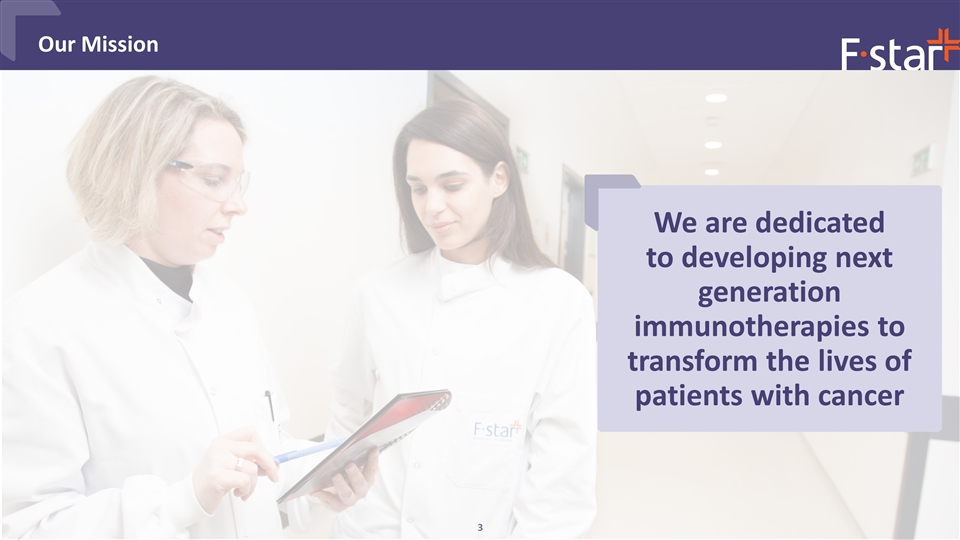
We are dedicated to developing next generation immunotherapies to transform the lives of patients with cancer Our Mission
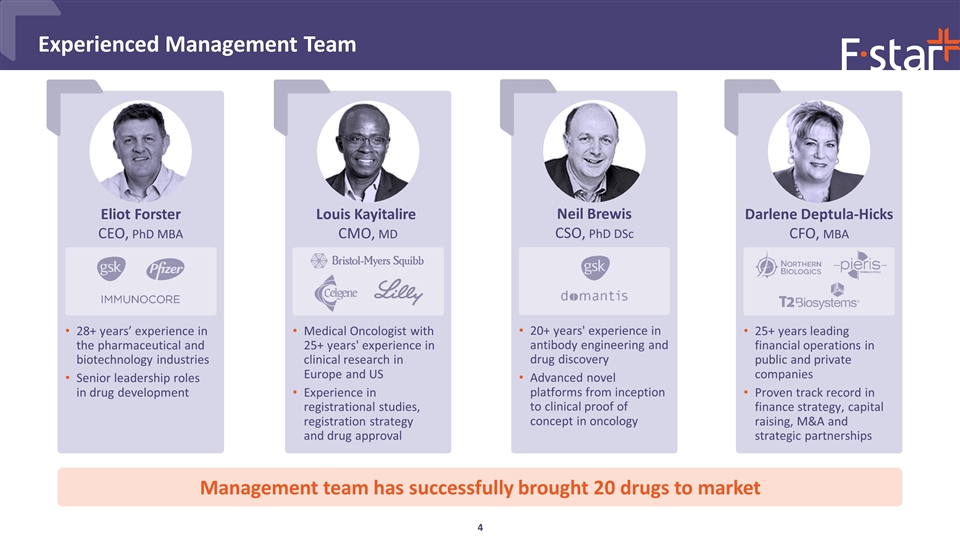
Experienced Management Team Medical Oncologist with 25+ years' experience in clinical research in Europe and US Experience in registrational studies, registration strategy and drug approval Louis Kayitalire CMO, MD 25+ years leading financial operations in public and private companies Proven track record in finance strategy, capital raising, M&A and strategic partnerships Darlene Deptula-Hicks CFO, MBA 28+ years’ experience in the pharmaceutical and biotechnology industries Senior leadership roles in drug development Eliot Forster CEO, PhD MBA 20+ years' experience in antibody engineering and drug discovery Advanced novel platforms from inception to clinical proof of concept in oncology Neil Brewis CSO, PhD DSc Management team has successfully brought 20 drugs to market
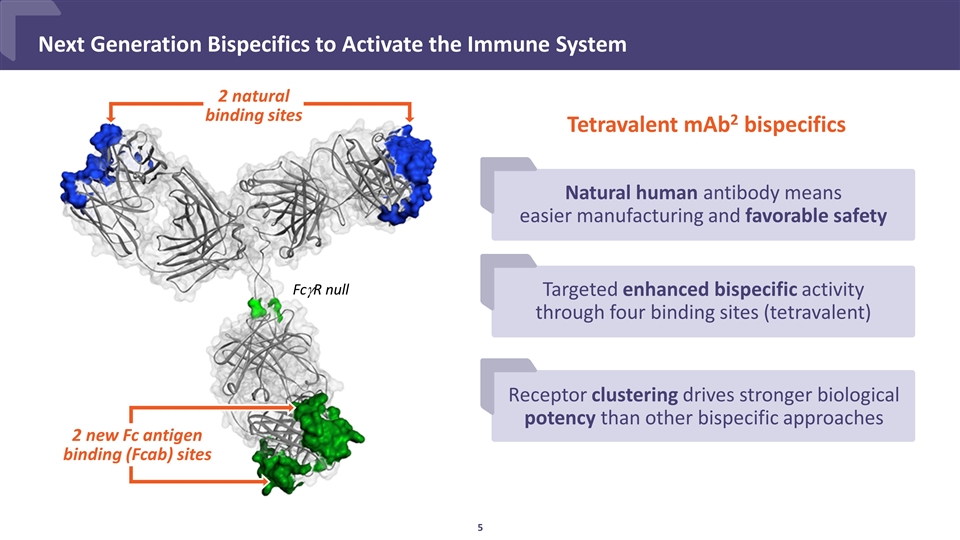
2 natural binding sites 2 new Fc antigen binding (Fcab) sites FcgR null Natural human antibody means easier manufacturing and favorable safety Targeted enhanced bispecific activity through four binding sites (tetravalent) Next Generation Bispecifics to Activate the Immune System Receptor clustering drives stronger biological potency than other bispecific approaches Tetravalent mAb2 bispecifics
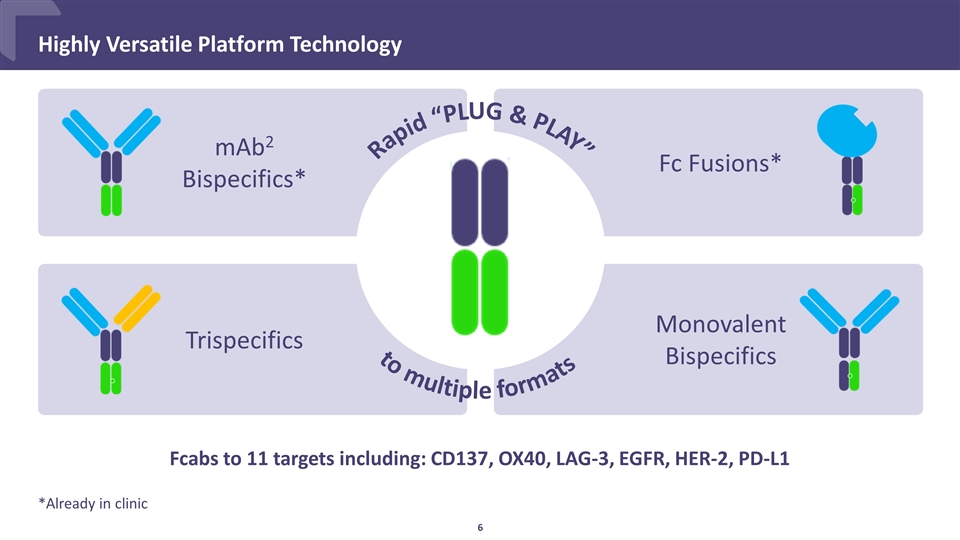
Highly Versatile Platform Technology Fcabs to 11 targets including: CD137, OX40, LAG-3, EGFR, HER-2, PD-L1 mAb2 Bispecifics* Trispecifics Fc Fusions* Monovalent Bispecifics Rapid “PLUG & PLAY” to multiple formats *Already in clinic
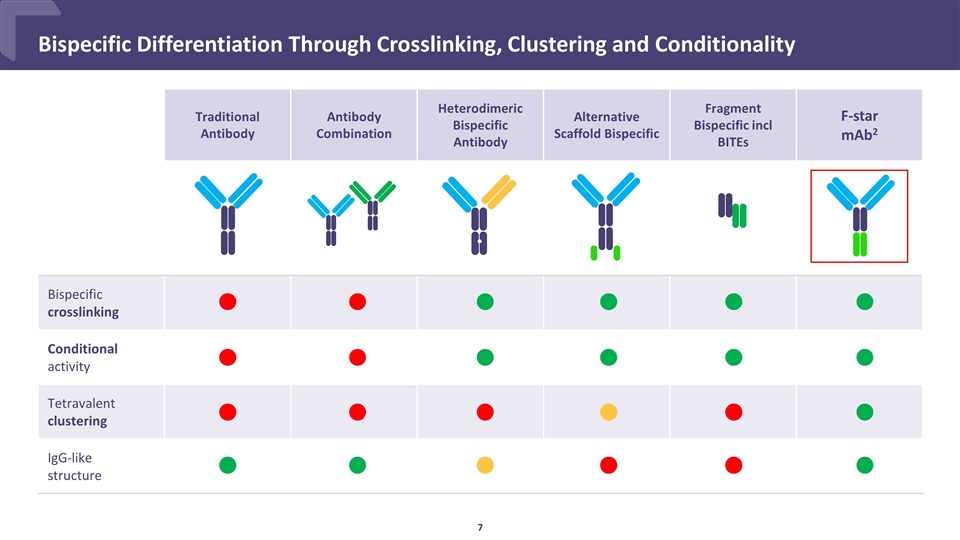
Bispecific Differentiation Through Crosslinking, Clustering and Conditionality Traditional Antibody Antibody Combination Heterodimeric Bispecific Antibody Alternative Scaffold Bispecific Fragment Bispecific incl BITEs F-star mAb2 Bispecific crosslinking Conditional activity Tetravalent clustering IgG-like structure

Next Generation Immunotherapies for Well Defined Tumor Settings 2020 2021 Clinical Programs Targets Opportunity Current Status Clinical Stage Preclinical Ph1 Ph2 FS118 LAG-3/PD-L1 Rescuing CPI treatment failures Q1 2021 US Phase 2 start in PD-1 resistant head & neck cancer patients FS120 OX40/CD137 Improving CPI and chemotherapy outcomes US Phase 1 trial: Monotherapy and PD-1 combo FS222 CD137/PD-L1 Improving outcomes in PD-L1 low tumors European Phase 1 trial SB 11285 STING pathway Improving CPI outcomes US Phase 1 trial: Monotherapy and PD-L1 combo

1st line Chemotherapy IO Combination (e.g. with IO, TKI, CTx) IO monotherapy 2nd line IO Combination (e.g. with IO, TKI, CTx) Non –IO (Primary resistance) IO monotherapy Typically PD-L1 low Typically PD-L1 high Long Term Positioning of F-star’s Programs in First and Second Line FS222 FS118 FS120 IO Metastatic Market >$30 BN SB 11285
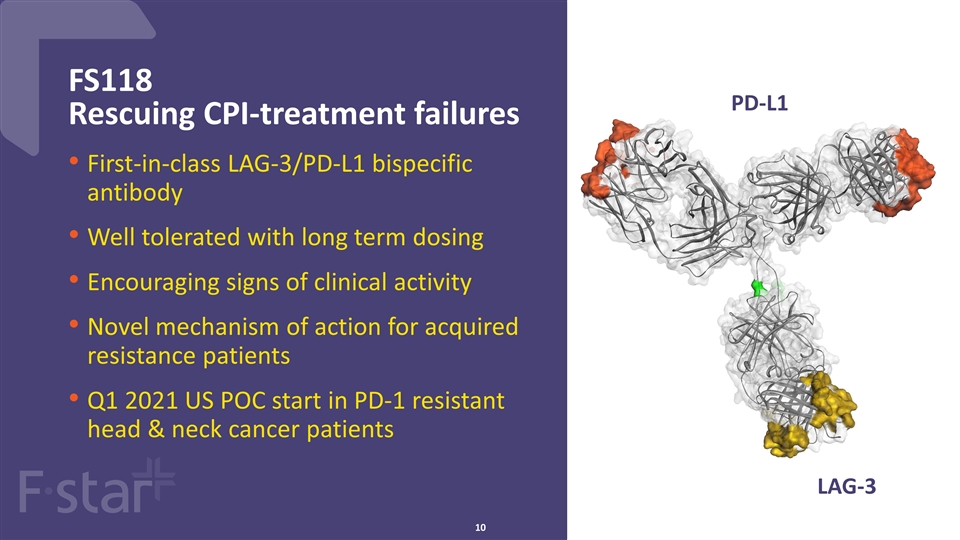
First-in-class LAG-3/PD-L1 bispecific antibody Well tolerated with long term dosing Encouraging signs of clinical activity Novel mechanism of action for acquired resistance patients Q1 2021 US POC start in PD-1 resistant head & neck cancer patients FS118 Rescuing CPI-treatment failures LAG-3 PD-L1
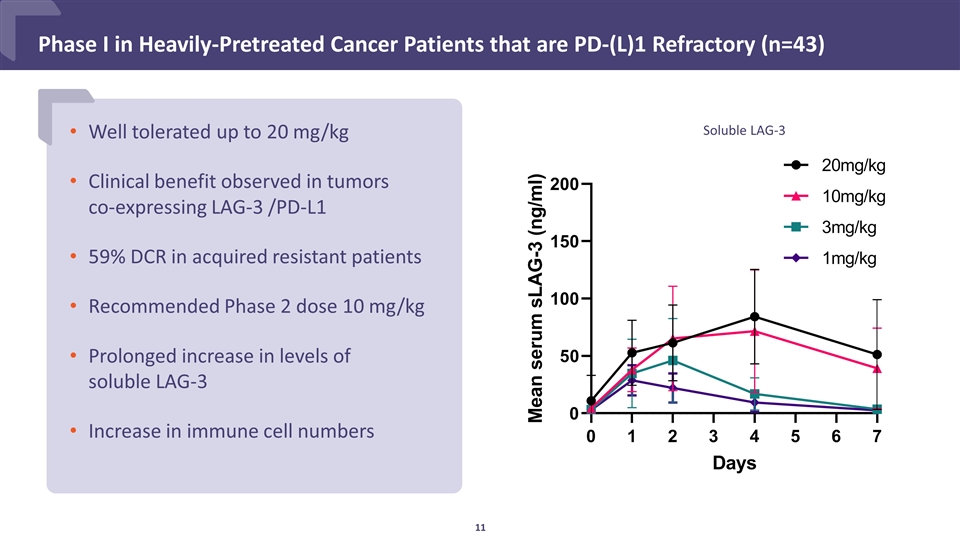
Phase I in Heavily-Pretreated Cancer Patients that are PD-(L)1 Refractory (n=43) Soluble LAG-3 Well tolerated up to 20 mg/kg Clinical benefit observed in tumors co-expressing LAG-3 /PD-L1 59% DCR in acquired resistant patients Recommended Phase 2 dose 10 mg/kg Prolonged increase in levels of soluble LAG-3 Increase in immune cell numbers
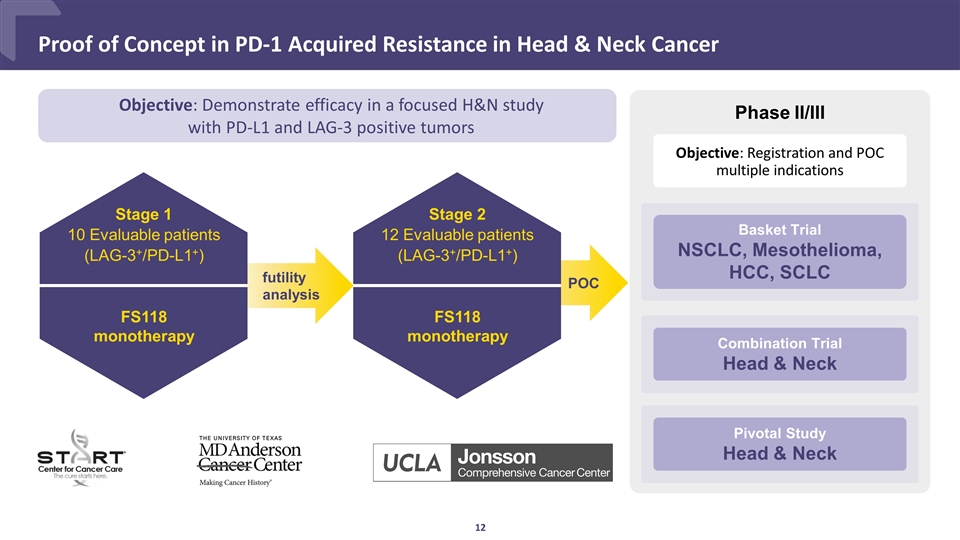
Proof of Concept in PD-1 Acquired Resistance in Head & Neck Cancer Stage 1 10 Evaluable patients (LAG-3+/PD-L1+) FS118 monotherapy futility analysis Objective: Demonstrate efficacy in a focused H&N study with PD-L1 and LAG-3 positive tumors Stage 2 12 Evaluable patients (LAG-3+/PD-L1+) FS118 monotherapy Phase II/III Basket Trial NSCLC, Mesothelioma, HCC, SCLC Objective: Registration and POC multiple indications Combination Trial Head & Neck Pivotal Study Head & Neck POC
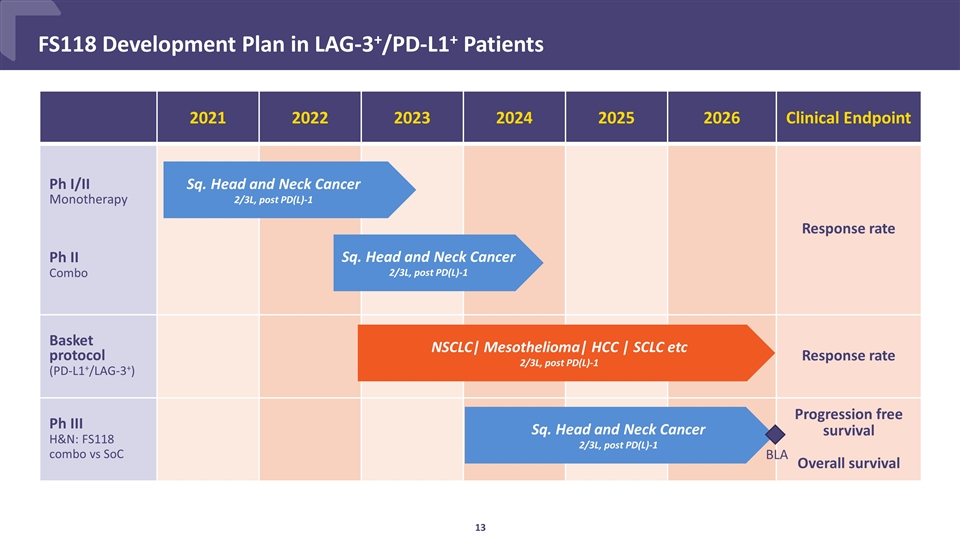
FS118 Development Plan in LAG-3+/PD-L1+ Patients 2021 2022 2023 2024 2025 2026 Clinical Endpoint Ph I/II Monotherapy Ph II Combo Response rate Basket protocol (PD-L1+/LAG-3+) Response rate Ph III H&N: FS118 combo vs SoC Progression free survival Overall survival NSCLC| Mesothelioma| HCC | SCLC etc 2/3L, post PD(L)-1 Sq. Head and Neck Cancer 2/3L, post PD(L)-1 Sq. Head and Neck Cancer 2/3L, post PD(L)-1 Sq. Head and Neck Cancer 2/3L, post PD(L)-1 BLA
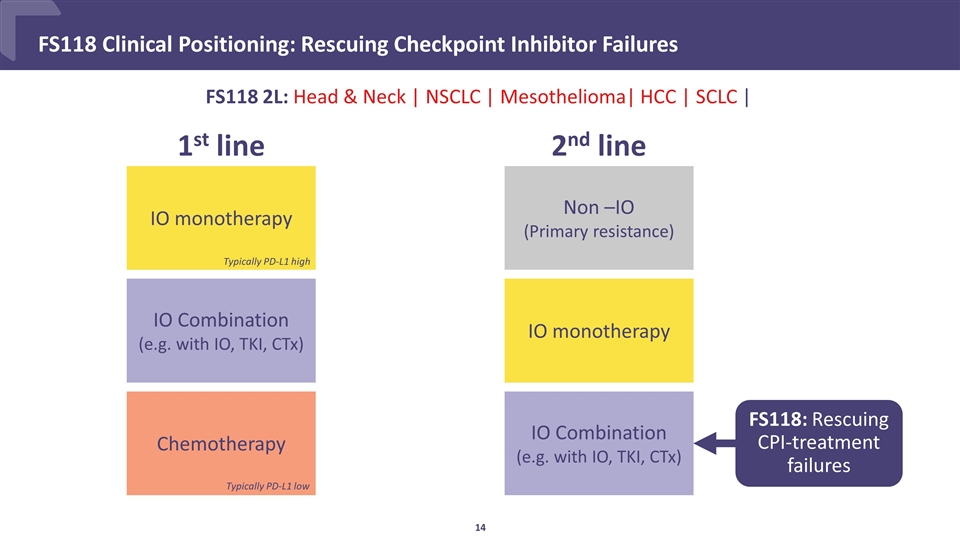
FS118 Clinical Positioning: Rescuing Checkpoint Inhibitor Failures FS118: Rescuing CPI-treatment failures FS118 2L: Head & Neck | NSCLC | Mesothelioma| HCC | SCLC | 1st line Chemotherapy IO Combination (e.g. with IO, TKI, CTx) IO monotherapy 2nd line IO Combination (e.g. with IO, TKI, CTx) Non –IO (Primary resistance) IO monotherapy Typically PD-L1 low Typically PD-L1 high
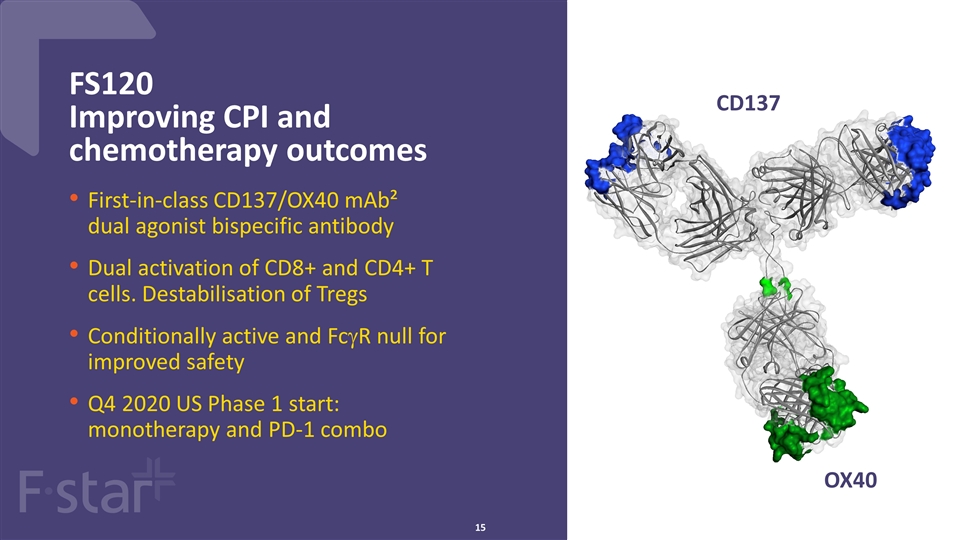
FS120 Improving CPI and chemotherapy outcomes First-in-class CD137/OX40 mAb² dual agonist bispecific antibody Dual activation of CD8+ and CD4+ T cells. Destabilisation of Tregs Conditionally active and FcgR null for improved safety Q4 2020 US Phase 1 start: monotherapy and PD-1 combo OX40 CD137
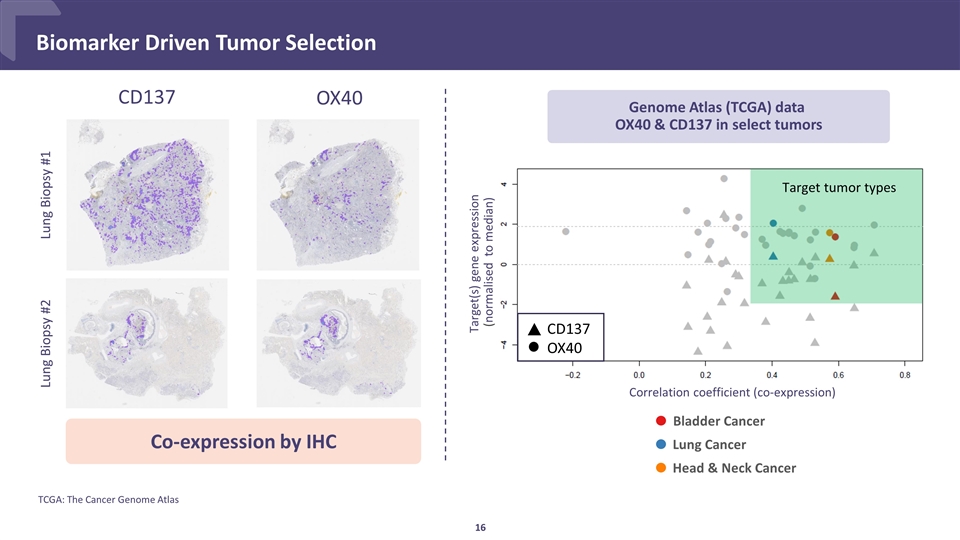
Biomarker Driven Tumor Selection Correlation coefficient (co-expression) Genome Atlas (TCGA) data OX40 & CD137 in select tumors Target(s) gene expression (normalised to median) CD137 OX40 Lung Biopsy #1 Lung Biopsy #2 Co-expression by IHC Lung Cancer Bladder Cancer Head & Neck Cancer Target tumor types CD137 OX40 TCGA: The Cancer Genome Atlas
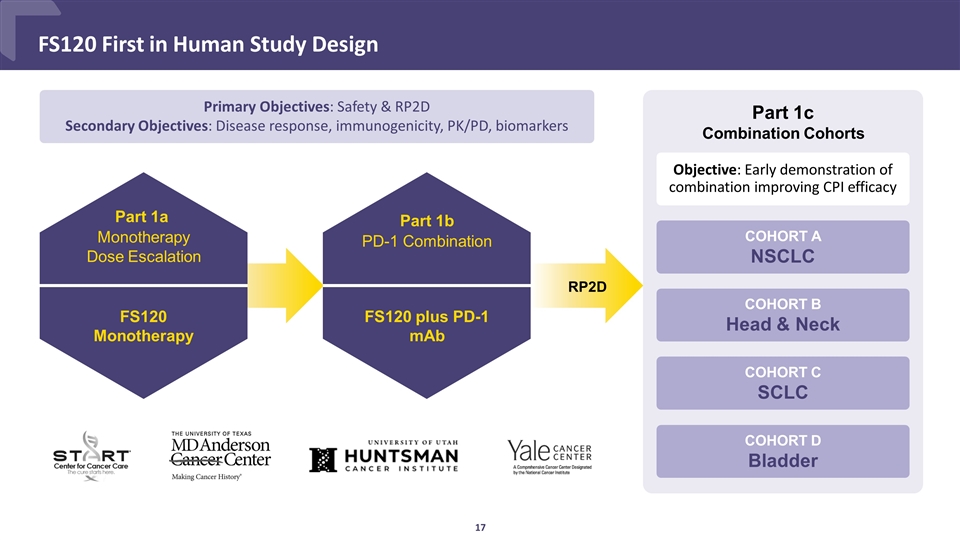
FS120 First in Human Study Design Part 1a Monotherapy Dose Escalation FS120 Monotherapy Part 1b PD-1 Combination FS120 plus PD-1 mAb Part 1c Combination Cohorts COHORT A NSCLC Objective: Early demonstration of combination improving CPI efficacy COHORT B Head & Neck COHORT C SCLC COHORT D Bladder Primary Objectives: Safety & RP2D Secondary Objectives: Disease response, immunogenicity, PK/PD, biomarkers RP2D

FS120 Development Plan: Combination with PD-1 in Early Lines of Therapy 2020 2021 2022 2023 2024 Clinical Endpoint Phase I: Part A Monotherapy Part B PD-1 Combination Part C PD-1 Combination tumor specific expansion Safety, PK, biomarker, RP2D for mono and combo Response rate, Duration of response Phase II/III: Clinical program acceleration Progression free survival Overall survival Dose escalation: All-comers Combination dose finding Registration Intent NSCLC Head & Neck SCLC u PAD* *PAD = Pharmacologically Active Dose Bladder
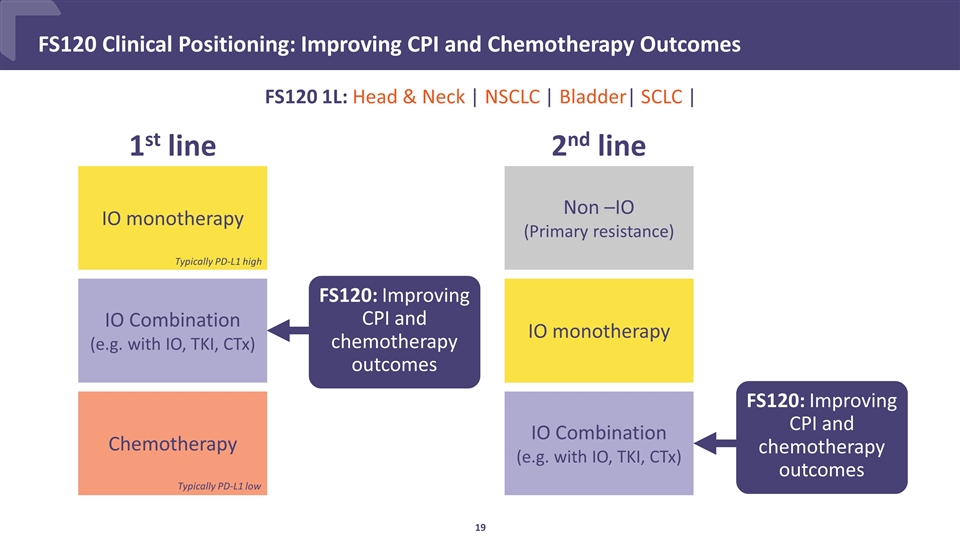
FS120 Clinical Positioning: Improving CPI and Chemotherapy Outcomes FS120 1L: Head & Neck | NSCLC | Bladder| SCLC | 1st line Chemotherapy IO Combination (e.g. with IO, TKI, CTx) IO monotherapy 2nd line IO Combination (e.g. with IO, TKI, CTx) Non –IO (Primary resistance) IO monotherapy Typically PD-L1 low Typically PD-L1 high FS120: Improving CPI and chemotherapy outcomes FS120: Improving CPI and chemotherapy outcomes

FS222 Improving outcomes in PD-L1 low tumors CD137/PD-L1 mAb² bispecific antibody Redirecting activated immune cells to the tumor Q1 2021 European Phase 1 start CD137 PD-L1

FS222 First in Human Study Design Part 1a Monotherapy Dose Escalation FS222 monotherapy RP2D Primary Objectives: Safety & RP2D Secondary Objectives: Disease response, immunogenicity, PK/PD, biomarkers Part 1b Expansion Cohorts COHORT A NSCLC (targeted subgroup) Objective: Early demonstration of clinical efficacy in patients with low PD-L1 tumors COHORT B Colorectal COHORT C Esophageal COHORT D Ovarian
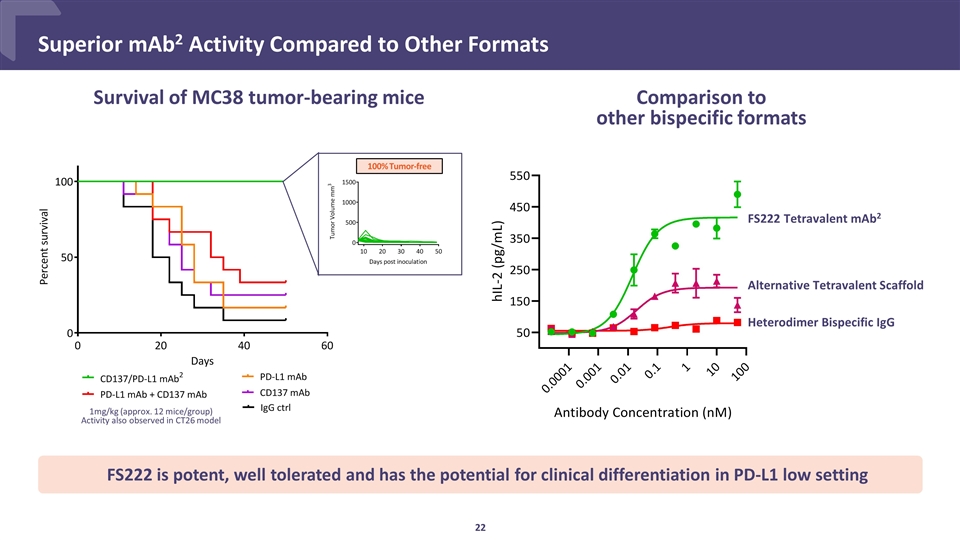
Superior mAb2 Activity Compared to Other Formats FS222 is potent, well tolerated and has the potential for clinical differentiation in PD-L1 low setting 1mg/kg (approx. 12 mice/group) Activity also observed in CT26 model Comparison to other bispecific formats 100% Tumor-free Survival of MC38 tumor-bearing mice FS222 Tetravalent mAb2 Heterodimer Bispecific IgG Alternative Tetravalent Scaffold
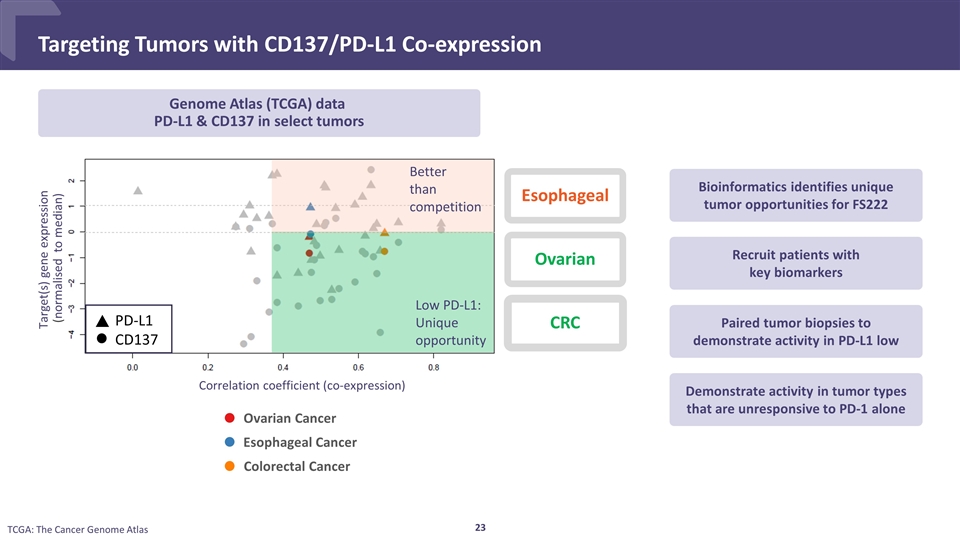
Targeting Tumors with CD137/PD-L1 Co-expression Correlation coefficient (co-expression) Genome Atlas (TCGA) data PD-L1 & CD137 in select tumors Target(s) gene expression (normalised to median) Esophageal Cancer Ovarian Cancer Colorectal Cancer Low PD-L1: Unique opportunity Better than competition PD-L1 CD137 TCGA: The Cancer Genome Atlas Bioinformatics identifies unique tumor opportunities for FS222 Recruit patients with key biomarkers Paired tumor biopsies to demonstrate activity in PD-L1 low Demonstrate activity in tumor types that are unresponsive to PD-1 alone Esophageal Ovarian CRC
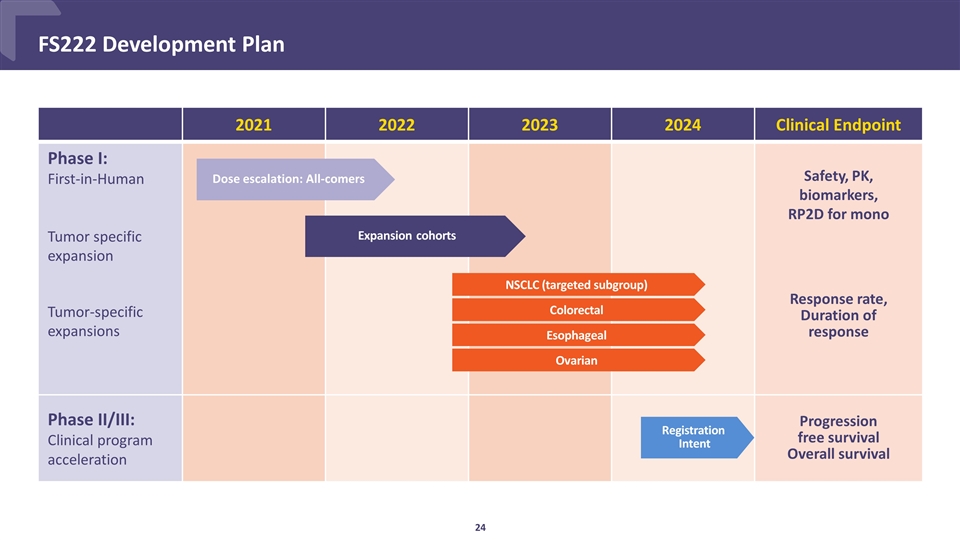
PD-L1 FS222 Development Plan 2021 2022 2023 2024 Clinical Endpoint Phase I: First-in-Human Tumor specific expansion Tumor-specific expansions Safety, PK, biomarkers, RP2D for mono Response rate, Duration of response Phase II/III: Clinical program acceleration Progression free survival Overall survival Expansion cohorts Dose escalation: All-comers NSCLC (targeted subgroup) Colorectal Esophageal Ovarian Registration Intent
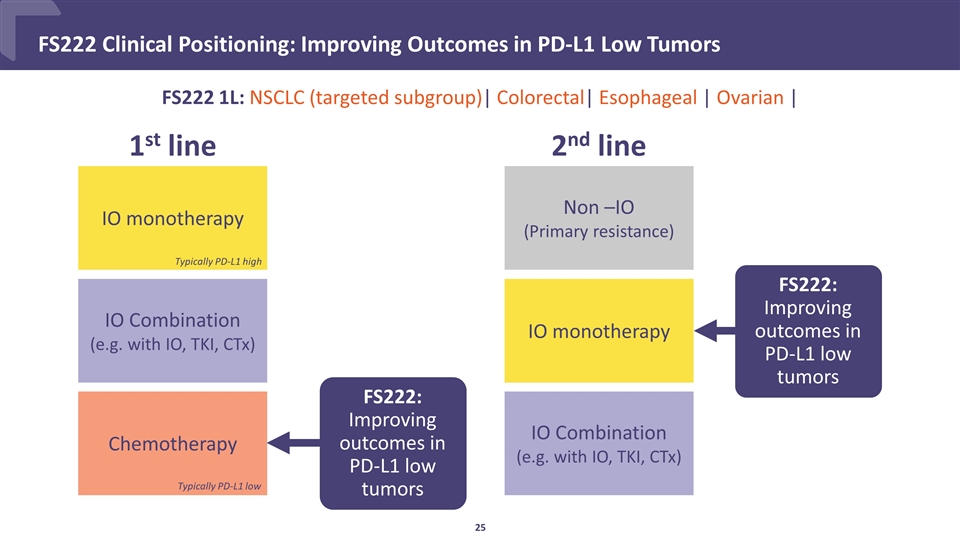
1st line Chemotherapy IO Combination (e.g. with IO, TKI, CTx) IO monotherapy 2nd line IO Combination (e.g. with IO, TKI, CTx) Non –IO (Primary resistance) IO monotherapy Typically PD-L1 low Typically PD-L1 high FS222 Clinical Positioning: Improving Outcomes in PD-L1 Low Tumors FS222 1L: NSCLC (targeted subgroup)| Colorectal| Esophageal | Ovarian | FS222: Improving outcomes in PD-L1 low tumors FS222: Improving outcomes in PD-L1 low tumors
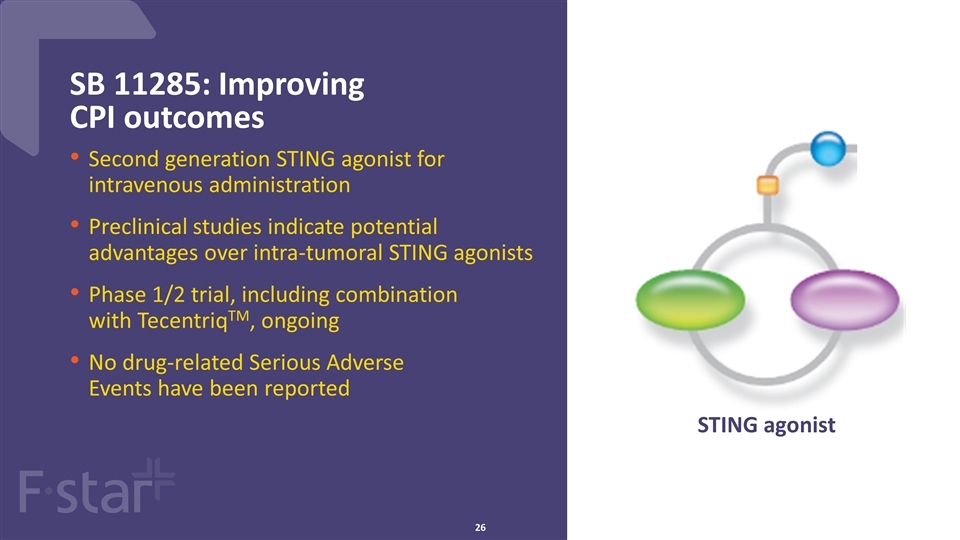
SB 11285: Improving CPI outcomes Second generation STING agonist for intravenous administration Preclinical studies indicate potential advantages over intra-tumoral STING agonists Phase 1/2 trial, including combination with TecentriqTM, ongoing No drug-related Serious Adverse Events have been reported STING agonist
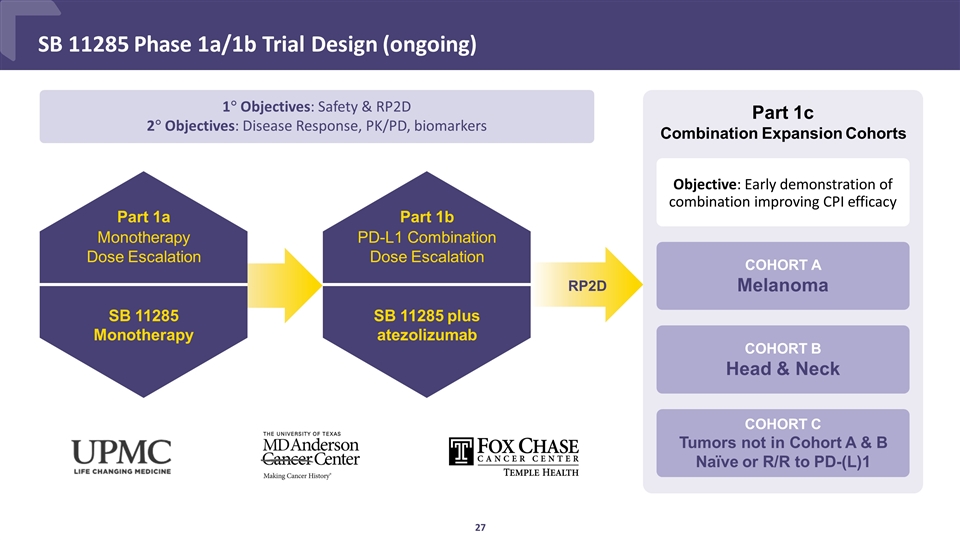
SB 11285 Phase 1a/1b Trial Design (ongoing) 1° Objectives: Safety & RP2D 2° Objectives: Disease Response, PK/PD, biomarkers Part 1a Monotherapy Dose Escalation SB 11285 Monotherapy Part 1b PD-L1 Combination Dose Escalation SB 11285 plus atezolizumab RP2D Part 1c Combination Expansion Cohorts COHORT A Melanoma Objective: Early demonstration of combination improving CPI efficacy COHORT B Head & Neck COHORT C Tumors not in Cohort A & B Naïve or R/R to PD-(L)1
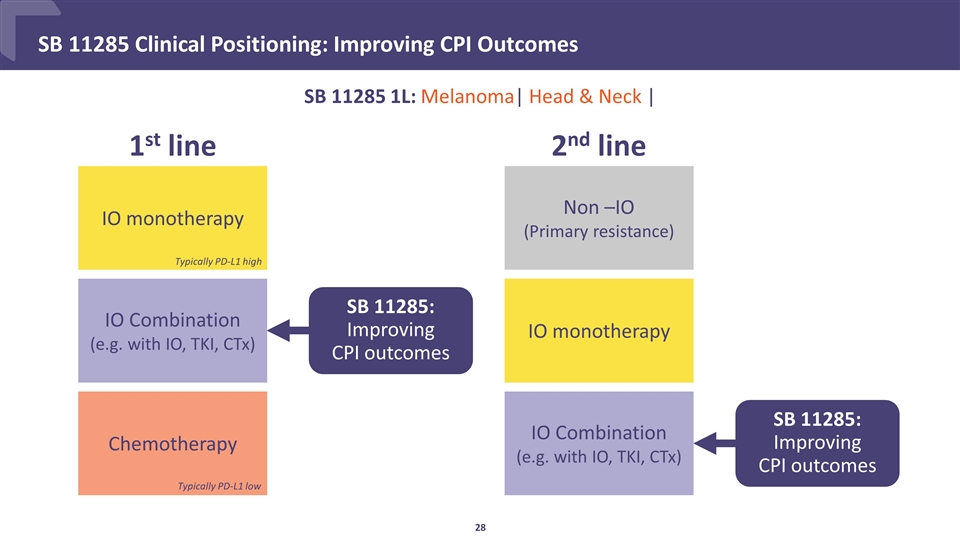
SB 11285 Clinical Positioning: Improving CPI Outcomes 1st line Chemotherapy IO Combination (e.g. with IO, TKI, CTx) IO monotherapy 2nd line IO Combination (e.g. with IO, TKI, CTx) Non –IO (Primary resistance) IO monotherapy Typically PD-L1 low Typically PD-L1 high SB 11285 1L: Melanoma| Head & Neck | SB 11285: Improving CPI outcomes SB 11285: Improving CPI outcomes

Q1 2021 Q2 2021 Q3 2021 Q4 2021 Q1 2022 Q2 2022 Q3 2022 Q4 2022 Q1 2023 Q2 2023 Q3 2023 Q4 2023 Anticipated Future Data Milestones Ongoing additional external clinical validation from third parties FS118 update on phase 2 PoC trial in PD-1 acquired resistance patients FS118 Completion of PoC trial FS118 Update on progress of basket and registrational trial(s) FS120 Update on accelerated dose titration FS222 initiation of PK/PD expansion cohorts FS222 Update on dose escalation FS222 initiation of tumour specific expansion cohorts FS120 update on combination cohorts FS120 Initiation of PD-1 combination cohorts SB 11285 Ph 1a/b including Tecentriq™ combination update:

Thank you.
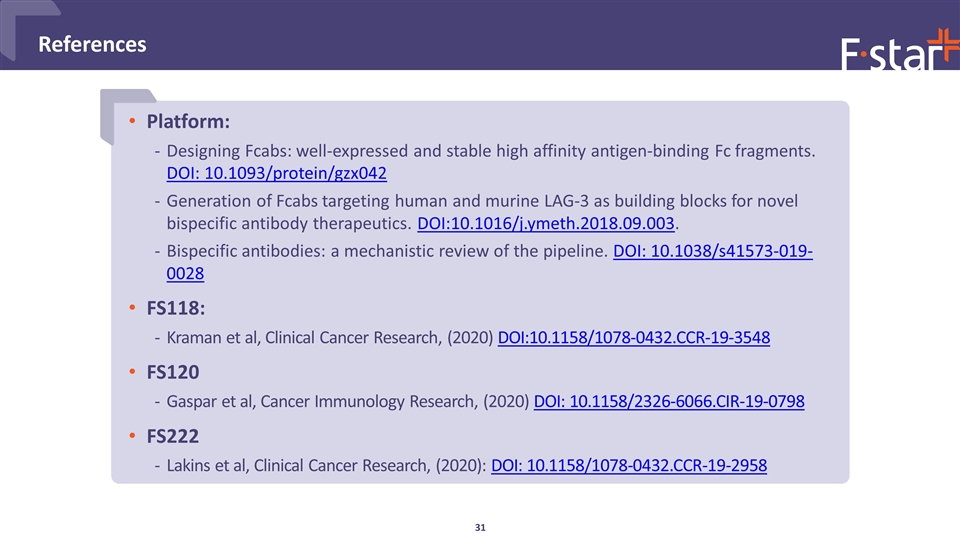
Platform: Designing Fcabs: well-expressed and stable high affinity antigen-binding Fc fragments. DOI: 10.1093/protein/gzx042 Generation of Fcabs targeting human and murine LAG-3 as building blocks for novel bispecific antibody therapeutics. DOI:10.1016/j.ymeth.2018.09.003. Bispecific antibodies: a mechanistic review of the pipeline. DOI: 10.1038/s41573-019-0028 FS118: Kraman et al, Clinical Cancer Research, (2020) DOI:10.1158/1078-0432.CCR-19-3548 FS120 Gaspar et al, Cancer Immunology Research, (2020) DOI: 10.1158/2326-6066.CIR-19-0798 FS222 Lakins et al, Clinical Cancer Research, (2020): DOI: 10.1158/1078-0432.CCR-19-2958 References
